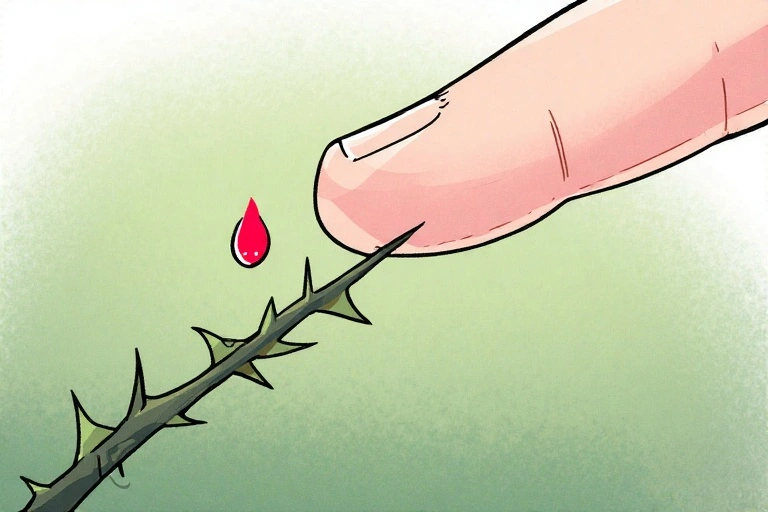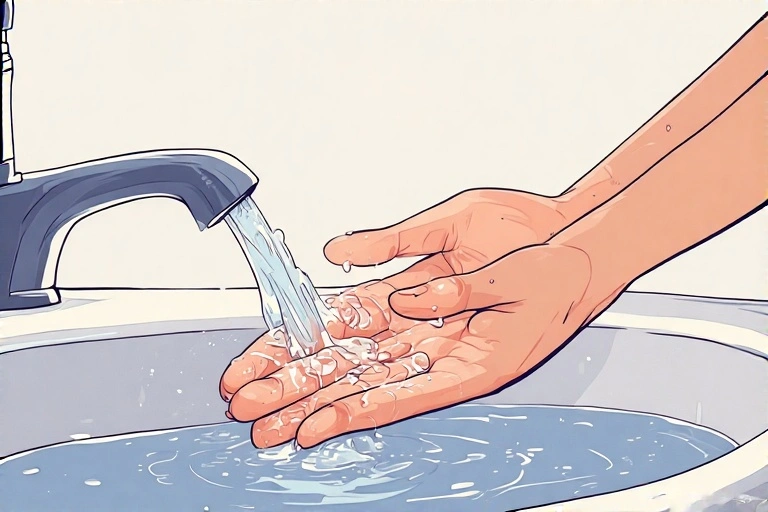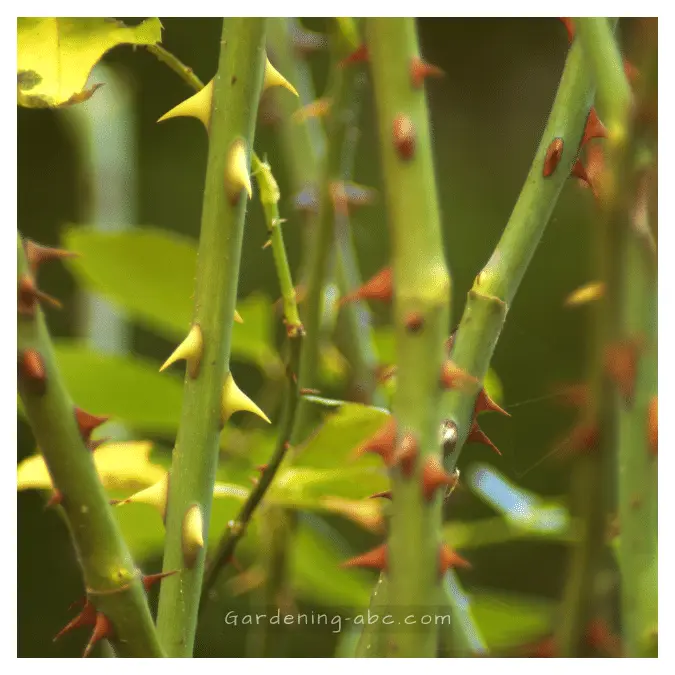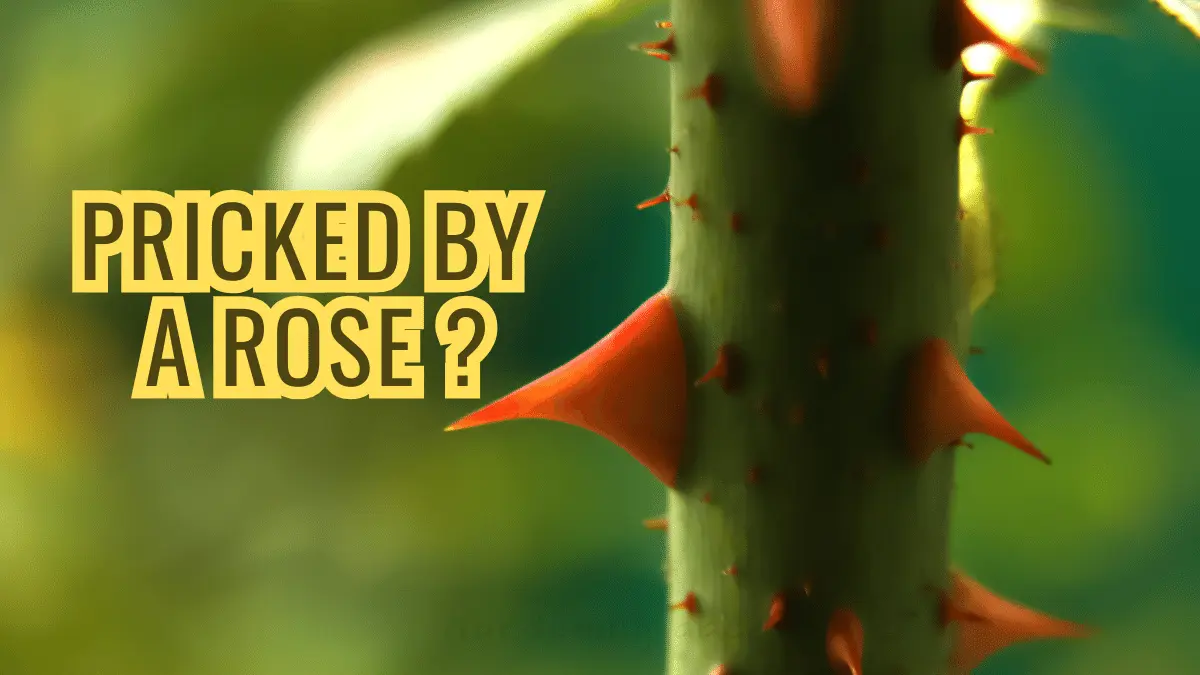We use affiliate links to run our site. When you buy through links on our site, we may earn an affiliate commission, without any added cost to you. Learn more
Pricking your finger on a rose thorn can be painful and concerning. Rose thorns contain bacteria that can potentially cause an infection if left untreated. By taking immediate action and proper wound care, you can effectively treat a rose thorn prick and prevent complications.
This guide covers crucial steps to properly deal with rose thorn punctures.
Immediately Remove the Thorn

As soon as a rose thorn punctures your skin, promptly remove it. Leaving the thorn lodged can push bacteria deeper into the wound, making an infection more likely.
Carefully grip the protruding end of the thorn using tweezers or needle-nose pliers. Pull it directly outward in a smooth motion to avoid breaking it off under your skin.
Take care when removing thorns from sensitive areas like fingers, since moving the thorn can be painful. If unable to fully remove it, seek medical help to extract it properly and prevent fragments from being left behind.
Clean the Wound Thoroughly

After removing the thorn, immediately clean the affected area. Wash your hands thoroughly with soap and water first.
Then, use mild soap and warm water to gently wash the puncture for at least 20 seconds. This helps remove bacteria, debris, and any remnants of the rose thorn from the wound.
Avoid using hydrogen peroxide or alcohol to clean the puncture as these can damage tissue and delay healing.
Also, do not apply lotions, creams, or medicated ointments before cleaning, as these can seal in contamination. Thorough cleaning is crucial for preventing infection.
Apply Antibiotic Ointment
After washing, apply an antibiotic ointment like Neosporin to the puncture. Antibiotic ointments create a barrier that prevents bacterial growth and potential infection.
Cover the ointment with a sterile bandage or gauze pad to keep the wound moist and protected.
Consider using a non-stick pad or bandage, which won’t stick to the wound as it heals. Wrap fingers or hands with gauze to prevent bandages from slipping off.
Check and change the bandage daily, cleaning the area and reapplying antibiotic ointment.
- Old-School, Easy-To-Use Design That’s Been Around Since 1913. Please…
- Easy & Simple Weeding Tool That Saves Your Back & Knees With Grampa’s…
- Grampa’s Weeder Is The Original Garden Weeder & Has Been Removing…
- This Stand Up Weeder Features A 4-Claw Design That Tackles Weeds On…
Seek Medical Care if Needed
Most rose thorn pricks are minor and can be treated at home. However, seek medical care if the puncture is deep, the wound is gaping open, or you experience excessive bleeding that won’t stop after 10 minutes of applied pressure.
Signs of a possible infection like increasing redness, warmth, swelling, oozing, or a red streak leading from the wound also warrant medical evaluation.
Tetanus immunization may be needed if you haven’t had a tetanus booster in the past 5 years.
Monitor the Wound for 48 Hours
Carefully monitor the wound site for the first 48 hours after being pricked. Check for signs of infection like increasing pain, swelling, redness, warmth, or green/yellow discharge. Fever, generally feeling unwell, and redness streaking from the wound can also indicate infection.
If any of these symptoms develop, seek prompt medical attention. Catching an infection quickly improves outcomes and prevents complications like abscess or blood poisoning. Notify your doctor if the wound shows no signs of healing after a several days.


Manage Pain and Itching
The puncture wound may be painful or itchy as it heals. Over-the-counter medications can provide relief:
- Avoid scratching, which can damage healing tissues.
- Apply cool compresses to minimize swelling and discomfort. Elevating the injured area can also help reduce inflammation.
- Pain typically improves within a few days but see your doctor if symptoms persist beyond one week. Significant or worsening pain may indicate an issue.
Take Precautions to Avoid Future Pricks


Be proactive and take precautions to avoid painful rose thorn pricks:
- Wear gloves and long sleeves when pruning roses or working around thorny plants. Leather gloves provide the best protection.
- Use pruning tools instead of hands when thinning out roses and cutting flowers. Tools give your hands distance from thorns.
- Check plants carefully for thorns before picking flowers or touching branches with bare hands.
- Keep fingernails trimmed short to prevent thorns from embedding under nails if pricked.
- Teach children to be cautious around thorny plants and NOT to grab roses with bare hands. Monitor for thorns if allowing handle plants.
Simple preventative measures can reduce the chances of irritating puncture wounds while gardening and arranging flowers.
- Breathable Gardening Gloves– Pigskin provides the best breathability…
- Strength & Durability: 100% natural premium pigskin leather gardening…
- Elbow-length Gauntlet Cuff: Extended pigskin leather cuff protects…
- Reinforced Protection: Puncture resistant padded palm and fingertips,…
Monitor for Signs of Infection
Being vigilant about infection prevention is key when recovering from a rose thorn puncture. Signs of infection include:
- Increased pain, swelling, warmth, or redness at the puncture site
- Red streaking from the wound
- Green, yellow, or foul-smelling discharge
- Fever or flu-like illness
If you notice any of these symptoms, promptly contact your doctor for evaluation and treatment. You may need oral antibiotic therapy or an antibiotic shot to clear the infection. Ignoring the signs of infection can lead to dangerous complications.
See your doctor if the wound shows no signs of healing after 5-7 days. Non-healing or slow healing suggests there may be debris or contamination prolonging healing. Medical care can improve outcomes. Monitor the site for at least two weeks after the initial prick for any changes.
Frequently Asked Questions
How soon after being pricked do I need to take action?
Remove the thorn and clean the area immediately, within the first several minutes if possible. Quick action reduces the chances of infection.
For how long do I need to watch for signs of infection?
Monitor the wound for up to 2 weeks after being pricked. Infections are most likely to occur within 48 hours but can still develop after this window.
Can I put alcohol or hydrogen peroxide on the puncture?
No. These can damage tissue and delay healing. Use mild soap and water to clean.
How soon can I get the wound wet?
Keep the bandaged area dry for 24 hours. After that, gentle washing and water exposure is fine. Avoid soaking until fully healed.
When should I seek medical treatment?
See a doctor promptly if you can’t fully remove the thorn, experience heavy bleeding, or notice signs of infection like increasing redness/swelling.
How can I prevent rose thorn puncture wounds?
Wear protective gloves and clothing when handling roses. Use tools instead of bare hands when possible. Check plants thoroughly for thorns before handling with bare hands.
Final Thought:


Rose thorns can introduce bacteria deep into the skin, raising infection risks. Knowing what to do when pricked is crucial for prompt treatment.
Immediately remove the thorn and clean the area thoroughly with soap and water. Apply antibiotic ointment and monitor for any signs of infection.
With quick response and proper continued care, minor rose thorn punctures should heal without complication. Wearing protective garments during rose handling makes accidental pricks less likely.
To minimize infections or other issues when pricked, take swift action removing the thorn, washing the puncture, and bandaging it.
Continue monitoring the site vigilantly, watching for infection symptoms. Contact your doctor promptly if any concerns arise. Appropriate care helps puncture wounds from rose thorns heal quickly and without incident.
Amazon and the Amazon logo are trademarks of Amazon.com, Inc, or its affiliates.


Hi there! My name is Prasenjit and I’m an avid gardener and someone who has grown a passion for growing plants. From my hands-on experience, I have learned what works and what doesn’t. Here I share everything I have learned.


